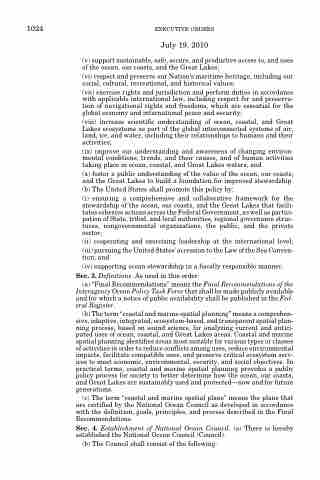Page 1034 - Demo
P. 1034
1024
EXECUTIVE ORDERS July 19, 2010
(v) support sustainable, safe, secure, and productive access to, and uses of the ocean, our coasts, and the Great Lakes;
(vi) respect and preserve our Nation’s maritime heritage, including our social, cultural, recreational, and historical values;
(vii) exercise rights and jurisdiction and perform duties in accordance with applicable international law, including respect for and preserva- tion of navigational rights and freedoms, which are essential for the global economy and international peace and security;
(viii) increase scientific understanding of ocean, coastal, and Great Lakes ecosystems as part of the global interconnected systems of air, land, ice, and water, including their relationships to humans and their activities;
(ix) improve our understanding and awareness of changing environ- mental conditions, trends, and their causes, and of human activities taking place in ocean, coastal, and Great Lakes waters; and
(x) foster a public understanding of the value of the ocean, our coasts, and the Great Lakes to build a foundation for improved stewardship.
(b) The United States shall promote this policy by:
(i) ensuring a comprehensive and collaborative framework for the stewardship of the ocean, our coasts, and the Great Lakes that facili- tates cohesive actions across the Federal Government, as well as partici- pation of State, tribal, and local authorities, regional governance struc- tures, nongovernmental organizations, the public, and the private sector;
(ii) cooperating and exercising leadership at the international level;
(iii) pursuing the United States’ accession to the Law of the Sea Conven- tion; and
(iv) supporting ocean stewardship in a fiscally responsible manner. Sec. 3. Definitions. As used in this order:
(a) ‘‘Final Recommendations’’ means the Final Recommendations of the Interagency Ocean Policy Task Force that shall be made publicly available and for which a notice of public availability shall be published in the Fed- eral Register.
(b) The term ‘‘coastal and marine spatial planning’’ means a comprehen- sive, adaptive, integrated, ecosystem-based, and transparent spatial plan- ning process, based on sound science, for analyzing current and antici- pated uses of ocean, coastal, and Great Lakes areas. Coastal and marine spatial planning identifies areas most suitable for various types or classes of activities in order to reduce conflicts among uses, reduce environmental impacts, facilitate compatible uses, and preserve critical ecosystem serv- ices to meet economic, environmental, security, and social objectives. In practical terms, coastal and marine spatial planning provides a public policy process for society to better determine how the ocean, our coasts, and Great Lakes are sustainably used and protected—now and for future generations.
(c) The term ‘‘coastal and marine spatial plans’’ means the plans that are certified by the National Ocean Council as developed in accordance with the definition, goals, principles, and process described in the Final Recommendations.
Sec. 4. Establishment of National Ocean Council. (a) There is hereby established the National Ocean Council (Council).
(b) The Council shall consist of the following:


